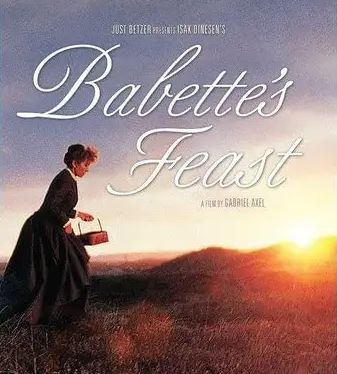Babettes gæstebud (1986)


Director: Gabriel Axel
Gastronomic Consultant: Jan Pedersen
Country: Denmark
Cuisine: Danish, French
Film Rating: 7/10
Foodie Rating: 4/10 (first half) 9/10 (conclusion)
Initially there is a touch of confusion: You are half an hour into Babette’s Feast and the eponymous Babette (Stéphane Audran), a housemaid for two elderly sisters Filippa (Bodil Kjer) & Martine (Birgitte Federspiel), daughters of the philanthropic pastor, has briefly popped into a dining room full of parishioners from the small coastal village in Jutland, Denmark, but has nothing appetising to serve.
A refugee from France, Babette has joined the household after being sent there by family friend Achille Papin (Jean-Philippe Lafont), who had taken a fancy to one of the sisters many years ago while teaching her to sing. The letter accompanying Babette indicates that ‘she can cook’ and so the kindly sisters take her in; she resides in the house working as the housemaid in exchange for lodging and food. She has to learn to prepare local dishes as well as speak Danish in order to fulfil her new role.
Ale bread soup is the first delicacy she is taught to cook – a spoon from a bowl consumed dark-brown mash of stale bread and…. ale. And so she continues to produce such bland culinary fare, for prayer and song accompany the meals that are served to the sisters and parishioners in this tiny community, although she is adept at purchasing the best quality produce and will not accept overpriced goods..
Babette does, however, hold some lottery cards back in France and her friend there ensures her continued participation. Over a dozen years after leaving her home country she wins 10,000 Francs. With the money arriving in time to commemorate what would have been the one hundredth birthday of the now deceased pastor, Babette decides to celebrate with a proper dinner. It turns out to be a feast but the villagers don’t want to acknowledge any sinful depravity associated with the celebration. All through her time washing salted fish and making ale bread soup in Jutland, Babette has had a hankering for home cuisine so splashes her new cash on procuring the ingredients to create and serve a lavish multiple course gastronomic extravaganza.
This is a film about an virtuous community, where the sisters have led a life of worship and charity, where frivolity is shunned and enjoyment of food considered to be self-indulgent. The religious group, whilst still gathering together, bicker amongst each other – their lives of austerity leading to petty squabbles. Babette conforms with the expectations of the society that has given her refuge but clearly yearns for her former life.
The feast affords her the opportunity to retain a flavour – if you will – of the culinary joys that she used to know and enjoy. The dinner includes Potage à la Tortue, blinis (although the ingredients, like much in the feast are imported so no local fish roe here, just the beluga), a salad course, Cailles en Sarcophage and a variety of fruits, cheeses. And of course there is a very good reason as to why this is such a special occasion.
Babette’s Feast is a gentle film, underplayed throughout, and its primary message is that just a soupçon of decadence and indulgence, hell, even a little gluttony, does you good.








